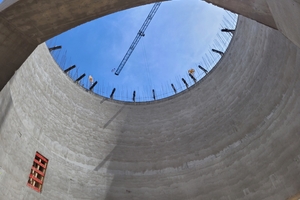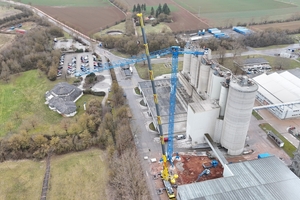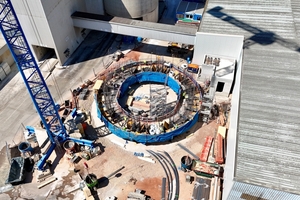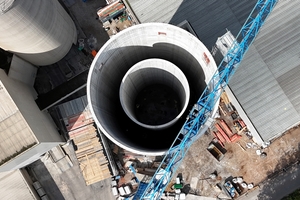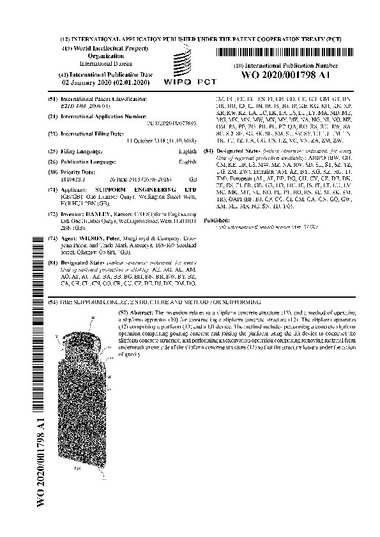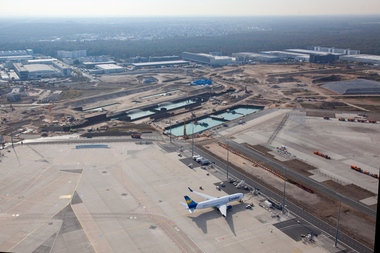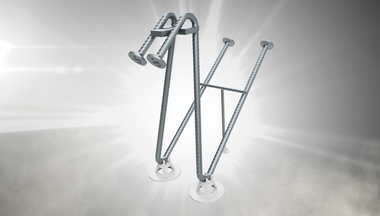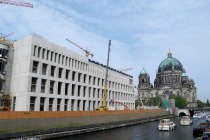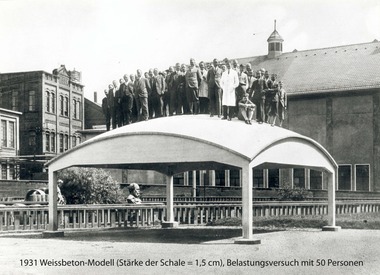New cement silo for a more climate-friendly future
The new cement silo 12 is being built at the Dyckerhoff Göllheim cement plant. The construction project is a key component of the CO2 reduction strategy across the group. With the new silo construction, Dyckerhoff makes an important investment into the future and preparations to expand the range of cements produced in Göllheim by additional CO2-reduced cements.
New Silo 12 in the Rhineland-Palatinate town of Göllheim
Construction works have been progressing rapidly since February 2025. Following the preparatory earth works, setting up the rotating tower crane and rerouting of sewer, water and power lines, the blinding layer was cast at the end of February, and formwork and reinforcement works for the silo foundation were carried out in March, with installing approx. 60 tons of steel. At the beginning of May, the placement of 710 m³ of concrete for the main foundation represented an important milestone. A concrete C30/37 with a CEM III/A 42.5 N cement was used here because of the massive volume of the structural component. Subsequently, the formwork removal, backfilling works and shell construction of the electrical room were completed successfully. After completion of these preparatory works, the crucial construction phase began in May: This is the first slipforming section of the exterior silo wall. The slipforming method requires careful preliminary planning and preparatory work. During the actual slipforming process there is no time at all to correct errors in planning. All necessary materials need to be on the construction site. The slipform is rising continuously (about 2.5 cm every 10 minutes) along so-called climbing poles which are embedded in concrete.
The concrete mix design has to be selected according to the slipforming speed, being required over a seven-hour period. Any variables (temperatures, embedded parts, reinforcement installation, etc.) have to be taken into account here. During a five-day, round-the-clock concreting process, from Monday at 1 a.m. to Friday midday, the first 18.5 m of the silo could be completed in a continuous construction process. After finishing the initial slipforming section, from mid-June onwards, the precast elements of the silo cone were installed and the in-situ concrete topping was poured. In the following step, the second slipforming section was continued over seven days without interruption so that the final silo height of 52.11 m could be reached at the end of July.
In order to adapt the concrete properties exactly to the requirements of the slipforming technology, a matrix of concrete formulations with varying degrees of fast and slow reactivities was prepared by the concrete supplier Trapobet Transportbeton GmbH Kaiserslautern KG – these were tested in several trial pours at the construction site. During the ongoing slipforming phase, the construction site could always order the appropriate concrete mix for the respective weather condition, time of day and speed of site team. At first, a concrete C30/37 containing 360 kg/m³ of CEM III/A 42.5 N was used.
So as to increase the slipforming speed too, up to 250 kg/m³ CEM II were gradually replaced with CEM II/A-LL 52.5 N in three steps.
Maximum capacity of 5,400 m³
The first 17 m of the new distribution silo were already completed a whole day ahead of the initial schedule, thanks to smooth reinforcement installation, concrete placement and incorporation of recess boxes. The second slipforming section could also be finished two days earlier because of the well-coordinated and smooth interaction between concrete placement, reinforcement installation and the incorporation of recesses as well as embedded parts.
After completion of the solid structure, the next project phase is going to start: Steel construction works and installation of technical equipment begin inside the silo. Subsequently, commissioning of the entire silo system will take place gradually. The new silo will have a maximum capacity of 5,400 m³ upon completion. The overall construction project is internally managed by Rudolf Kröll, CPE Project Manager. The professional implementation is carried out by Bauunternehmung Karl Gemünden GmbH & Co. KG located in Ingelheim am Rhein as main contractor and by Bitschnau Gleit & Schalungstechnik GmbH located in Nenzing (Austria) as subcontractor and specialist in slipforming construction. Concrete is supplied by Trapobet Transportbeton GmbH, using cements of Dyckerhoff exclusively.
The commissioning is scheduled for the first quarter of 2026. With the construction of this silo, Dyckerhoff underlines the commitment to a shift in the cement industry toward greater climate protection.
CONTACT
Dyckerhoff GmbH
Biebricher Str. 68
65203 Wiesbaden/Germany
+49 611 676-3173

